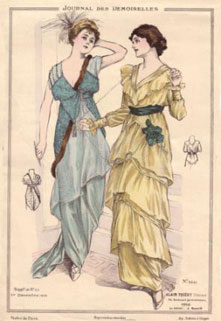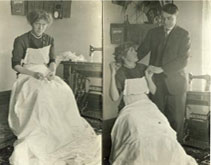|
TWO YOUNG WOMEN, Alice and Ida
Edwards came about 1894 to Hartney from
the Melita district, where their father was a pioneer farmer, and set
up a dress-making business above Dan Sutherland’s bakery. The demand
for dresses was so great that they soon had several assistants, among
them Miss Mary Morris. So their customers might be clad in the latest
fashion, the Edwards sisters visited Minneapolis to observe the styles
of that city and on their return created the floor-length,
stiffly-boned, high-collared frocks then in vogue. These were worn with
the large heavy hats and bonnets of velvet, silk and straw turned out
by a milliner at the A.E. Hill Co. store.
After running a successful business for over five years the Edwards
sisters were married on the same June day in 1900 at their father’s
Melita farm, Ida to A.E. Fry and Alice to Tom Hopkins. Ida and A.E. Fry
had planned a stylish wedding. Tom Hopkins and Alice Edwards were the
attendants. The Fry wedding was over, and guests returned to the
Edwards home when Tom and Alice announced their intention to be married
then and there.
The Edwards’ dress-making business passed into the hands of Misses Eva
and Emily Magwood who carried it on until they married and left
Hartney. Miss Irene McDermott, as milliner, worked with both the
Edwards and the Magwood sisters.
Another pair of sisters, Misses Margaret and Jennie McArter became well
known as dress-makers in the early years of the century. Miss Margaret
McArter was for many years in charge of the dress-making departments in
the J.C. Callander and A.E. Hill stores. Later she opened her own
business in her home which she operated for over 15 years until failing
health prevented her continuing.
In the days before ready-made dresses were available, it was customary
to have a seamstress to stay for a week or more in the home of her
customers in turn, to fashion dresses and other garments for the whole
family. Miss Jennie McArter, handicapped to a considerable degree by
arthritis, was one of those. Her services were booked ahead for many
weeks, particularly in the spring and fall. It was a thrill to have her
in the home, laden with all the latest fashion books. How the girls in
town enjoyed choosing the styles for their new dresses, and how weary
they grew from standing on floor and table to have their dresses
fitted. Miss Jennie McArter, a patient gentle woman had quantities of
beautiful auburn hair that she wore in an intricate coiffure. Arthritis
made it difficult for her to arrange her own hair and that was done for
her by the women at whose homes she sewed.

Couture dress designs from Paris, available in
popular magazines, influenced styles even in small towns like Hartney.
A courageous Hartney businesswoman was Mrs. Kate Maley. A widow in
Blackpool, England, with two small daughters that she supported by
dress-making and needlework, she decided to emigrate to Canada under
the farm-help scheme of the day. In 1905 she and her daughters, Peggy
and Molly, arrived in Canada. Mrs. Maley answered an advertisement in a
Winnipeg paper for a woman to assist at a farm home and soon she and
her daughters found themselves at the George Gibson home in the Barber
district.
Mrs. Maley’s ability as a dress-maker became known and soon she was
going from home to home to make dresses, while Mrs. Gibson kept Peggy
and Molly. Assisted financially by Mr. Gibson, Mrs. Maley rented rooms
above D.G. Ennis’s bakery and opened her own dress-making shop. Her
work advertised itself and she could not fill the orders, so she
accepted an offer from J.C. Callander to take charge of the
dress-making department in his store and secured several assistants.
During the summer of 1908 Mrs. Maley took a course in millinery at
Winnipeg, and with her taste and skill became as able a milliner as she
was a dress-maker. On her return to Hartney she opened a millinery
store in the Lewis building and rented the Dale house where her mother,
Mrs. Goslin joined her before Christmas 1908 to care for the family.
The following year Mrs. Maley bought the E.A. Cuthbert store to the
north of the Imperial Hotel, enlarged her business to include, beside
millinery, blouses, dresses and fancy goods, and moved her family into
the rooms over the store.
Unfortunately the steady sewing affected her eyes and Mrs. Maley, in
need of work that required less eye-strain, investigated homestead land
in the west. In June of 1910 she secured a homestead in the Monitor
district near Provost, Alberta, and after doing three months homestead
duty there returned to Hartney in time for the millinery season in the
fall. For the next three years she did her homestead duties in Alberta
as well as carrying on the millinery business in Hartney. Subsequently
the Maley family went to San Diego California, where Mrs. Maley died in
1956.
Adapted from The Mere
Living, page 214.
Making
a Dress in 1900
After marriage many women who were fully trained dressmakers would set
up as the little dressmaker who could interpret the latest mode at an
insignificant price. The answer was to select a dress design from a
glossy magazine, then turn to a local dressmaker with a manual Singer
sewing machine. The local dressmaker would run up a new gown very
cheaply.
Many dressmakers were employed solely to work on blouses. With its
profusion of lace and intricate details the blouse was a perfect
example of conspicuous waste and conspicuous consumption. Usually the
principal fabrics of the blouse were net and lace, cleverly pieced
together with faggotting and lace insertions. This was then further
trimmed with satin strappings and velvet ribbons. After 1905 cotton net
was sometimes embroidered with small designs of leaves, flowers or
spots and since the blouse was so fashionable, machine embroidery
both commercial and domestic flourished until 1914.
The trends that marked 1900-1910 fashions reflected a significant
turning point in history and style. The end of the Victorian era and
beginning of the Edwardian era, this period reflected the manner in
which men's and women's clothes were losing a little of their rigid
formality and becoming more useful.
An important aspect of 1900 to 1910 fashions is the change of
technology across many countries. The Industrial Revolution was in full
swing and cloth could now be mass produced. This led to clothing that
could be mass produced, which was an entirely new fashion concept.
People no longer had to make their clothes themselves or rely on a
seamstress or tailor. Some outfits could be bought off the rack for the
very first time.
Women adopted a simpler fashion form from 1900 to 1910 than they had
done in previous years. Restrictive corsets and high collars relaxed
slightly. Dresses were still the standard, but they no longer needed to
be puffed up around the hips with petticoats. Skirts became floor
length instead of trailing.
One of the popular styles later in the decade between 1900 to 1910 was
the hobble skirt. This skirt was somewhat full at the waist and tapered
towards the ankles. Hats were still all the rage and the larger the
better. It didn't matter what your hat was decorated with, as long as
it was decorated and big.

A seamstress working on a gown.
|





